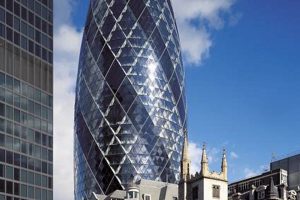The Skyscraper Museum is a museum in New York City dedicated to the history and architecture of skyscrapers. Founded in 1996, the museum is located in the historic Battery Park City neighborhood and features a collection of over 20,000 artifacts, including models, drawings, and photographs.
The Skyscraper Museum’s mission is to explore the history and impact of skyscrapers on our cities and culture. The museum’s exhibitions and programs examine the architectural, engineering, and social aspects of skyscrapers, and their role in shaping the urban landscape. The museum also hosts a variety of educational programs, including lectures, workshops, and tours.
The Skyscraper Museum is a valuable resource for anyone interested in the history and architecture of skyscrapers. The museum’s collection and exhibitions provide a unique insight into the design and construction of these iconic structures, and their impact on our cities and culture.
1. History
The history of skyscrapers is a fascinating one, and the Skyscraper Museum is the perfect place to learn about it. The museum’s collection includes over 20,000 artifacts, including models, drawings, and photographs that tell the story of skyscrapers from their early origins to their modern-day incarnations.
Skyscrapers are a relatively new invention, with the first true skyscraper, the Home Insurance Building in Chicago, being built in 1885. However, the concept of tall buildings has been around for centuries, with the Tower of Babel being one of the earliest examples. The Skyscraper Museum explores the history of skyscrapers in all its forms, from the early skyscrapers of the 19th century to the supertall skyscrapers of the 21st century.
The history of skyscrapers is also the history of cities. Skyscrapers have played a major role in the development of cities, and they continue to be a defining feature of urban landscapes around the world. The Skyscraper Museum’s collection includes artifacts from some of the most iconic skyscrapers in the world, including the Empire State Building, the Chrysler Building, and the World Trade Center.
The Skyscraper Museum is a valuable resource for anyone interested in the history of skyscrapers and cities. The museum’s collection and exhibitions provide a unique insight into the design and construction of these iconic structures, and their impact on our cities and culture.
2. Architecture
Architecture is a key component of the Skyscraper Museum, which examines the architectural aspects of skyscrapers, including their design, engineering, and construction. The museum’s collection includes over 20,000 artifacts, including models, drawings, and photographs that tell the story of skyscrapers from their early origins to their modern-day incarnations.
The Skyscraper Museum’s architecture exhibitions explore the design and construction of skyscrapers, from the early skyscrapers of the 19th century to the supertall skyscrapers of the 21st century. The museum’s collection includes artifacts from some of the most iconic skyscrapers in the world, including the Empire State Building, the Chrysler Building, and the World Trade Center.
The Skyscraper Museum’s architecture exhibitions are a valuable resource for anyone interested in the design and construction of skyscrapers. The museum’s collection and exhibitions provide a unique insight into the design and construction of these iconic structures, and their impact on our cities and culture.
3. Impact
Skyscrapers have a profound impact on our cities and culture. They are symbols of our technological and economic power, and they shape the way we live and work. The Skyscraper Museum explores the impact of skyscrapers on our cities and culture through its collection of over 20,000 artifacts, including models, drawings, and photographs.
- Economic Impact
Skyscrapers are major economic drivers. They create jobs, generate tax revenue, and support businesses. The construction of a single skyscraper can create thousands of jobs and generate millions of dollars in tax revenue. Skyscrapers also attract businesses, which in turn create jobs and boost the local economy.
- Social Impact
Skyscrapers have a significant social impact. They can create a sense of community and pride, and they can improve the quality of life for residents. Skyscrapers can also be used to create affordable housing and public spaces.
- Environmental Impact
Skyscrapers can have a negative environmental impact. They can consume large amounts of energy and water, and they can contribute to air pollution. However, skyscrapers can also be designed to be environmentally friendly. Green skyscrapers use sustainable design features to reduce their environmental impact.
- Cultural Impact
Skyscrapers are cultural icons. They are symbols of our technological and economic power, and they shape the way we think about cities. Skyscrapers have been featured in countless works of art, literature, and film.
The Skyscraper Museum’s collection and exhibitions provide a unique insight into the impact of skyscrapers on our cities and culture. The museum is a valuable resource for anyone interested in the history, architecture, and impact of skyscrapers.
4. Collection
The Skyscraper Museum’s collection is one of its most important assets. With over 20,000 artifacts related to skyscrapers, the museum has one of the most comprehensive collections of its kind in the world.
The collection includes a wide range of items, including models, drawings, photographs, and archival materials. These artifacts document the history of skyscrapers from their early origins to their modern-day incarnations.
The museum’s collection is a valuable resource for researchers, students, and anyone interested in the history and architecture of skyscrapers.
The collection is also used to support the museum’s exhibitions and programs. The museum’s exhibitions often feature artifacts from the collection, and the museum’s educational programs use the collection to teach students about the history and architecture of skyscrapers.
The Skyscraper Museum’s collection is a vital part of the museum’s mission to explore the history and impact of skyscrapers on our cities and culture.
5. The Importance of Exhibitions at the Skyscraper Museum
The Skyscraper Museum hosts a variety of exhibitions on the history and architecture of skyscrapers. These exhibitions are an important part of the museum’s mission to explore the history and impact of skyscrapers on our cities and culture.
The museum’s exhibitions are curated by a team of experts, and they feature a wide range of artifacts from the museum’s collection. The exhibitions are designed to be informative and engaging, and they appeal to a wide audience, including architects, engineers, historians, and the general public.
The Skyscraper Museum’s exhibitions have been praised for their scholarship and their ability to communicate the importance of skyscrapers to a broad audience. The exhibitions have been featured in numerous publications, and they have been visited by millions of people from around the world.
The Skyscraper Museum’s exhibitions are an important resource for anyone interested in the history and architecture of skyscrapers. The exhibitions provide a unique opportunity to learn about the design, construction, and impact of these iconic structures.
6. Programs
The Skyscraper Museum offers a variety of educational programs, including lectures, workshops, and tours, that explore the history and architecture of skyscrapers. These programs are designed to engage and educate people of all ages about the importance of skyscrapers in our cities and culture.
- Lectures
The Skyscraper Museum’s lectures feature leading experts on the history and architecture of skyscrapers. These lectures cover a wide range of topics, from the early history of skyscrapers to the latest developments in skyscraper design and construction. - Workshops
The Skyscraper Museum’s workshops provide hands-on experience with the design and construction of skyscrapers. These workshops are led by experienced architects and engineers, and they are a great way to learn about the different aspects of skyscraper design and construction. - Tours
The Skyscraper Museum’s tours offer a unique opportunity to see the inside of some of the world’s most iconic skyscrapers. These tours are led by experienced docents, and they provide a fascinating glimpse into the design and construction of these amazing structures.
The Skyscraper Museum’s educational programs are an important part of the museum’s mission to explore the history and impact of skyscrapers on our cities and culture. These programs provide a unique opportunity to learn about the design, construction, and impact of these iconic structures.
7. Research
Research is a vital part of the Skyscraper Museum’s mission to explore the history and impact of skyscrapers on our cities and culture. The museum’s research team conducts a wide range of research projects, from historical studies of individual skyscrapers to comparative studies of skyscraper design and construction. This research helps the museum to develop its exhibitions and programs, and it also contributes to the broader body of knowledge about skyscrapers.
One of the most important aspects of the Skyscraper Museum’s research is its focus on the history of skyscrapers. The museum’s research team has conducted extensive research on the early history of skyscrapers, and it has also documented the development of skyscrapers in the 20th and 21st centuries. This research has helped to shed light on the evolution of skyscraper design and construction, and it has also helped to identify the key factors that have shaped the development of skyscrapers.
In addition to its historical research, the Skyscraper Museum also conducts research on the architecture of skyscrapers. The museum’s research team has studied the design and construction of skyscrapers from all over the world, and it has identified the key trends and developments in skyscraper architecture. This research has helped to inform the museum’s exhibitions and programs, and it has also contributed to the broader body of knowledge about skyscraper architecture.
The Skyscraper Museum’s research is an important resource for anyone interested in the history and architecture of skyscrapers. The museum’s research team has conducted a wide range of research projects, and its findings have helped to shed light on the evolution of skyscraper design and construction. This research has also helped to inform the museum’s exhibitions and programs, and it has contributed to the broader body of knowledge about skyscrapers.
8. Publications
The Skyscraper Museum is a leading center for the study and appreciation of skyscrapers. The museum’s publications program is an important part of its mission to explore the history and impact of skyscrapers on our cities and culture.
The museum’s publications include books, articles, and exhibition catalogs. These publications cover a wide range of topics, from the history of individual skyscrapers to the latest developments in skyscraper design and construction. The museum’s publications are written by leading experts in the field, and they are extensively illustrated with photographs, drawings, and other archival materials.
The museum’s publications are an important resource for anyone interested in the history and architecture of skyscrapers. They provide a unique opportunity to learn about the design, construction, and impact of these iconic structures.
One of the most important aspects of the museum’s publications program is its focus on the history of skyscrapers. The museum’s publications have helped to document the development of skyscrapers from their early origins to the present day. This research has helped to shed light on the evolution of skyscraper design and construction, and it has also helped to identify the key factors that have shaped the development of skyscrapers.
The museum’s publications are also important for their focus on the architecture of skyscrapers. The museum’s publications have helped to document the design and construction of skyscrapers from all over the world. This research has helped to identify the key trends and developments in skyscraper architecture, and it has also helped to inform the museum’s exhibitions and programs.
The Skyscraper Museum’s publications are an important resource for anyone interested in the history and architecture of skyscrapers. The museum’s publications provide a unique opportunity to learn about the design, construction, and impact of these iconic structures.
FAQs about The Skyscraper Museum
The Skyscraper Museum is a leading center for the study and appreciation of skyscrapers. The museum’s FAQs address common concerns or misconceptions about skyscrapers and provide informative answers.
Question 1: What is the history of skyscrapers?
Skyscrapers have a long and fascinating history, dating back to the late 19th century. The first skyscrapers were built in Chicago in the 1880s, an
d they quickly became a symbol of American economic and technological power. Skyscrapers continued to be built throughout the 20th century, and they reached new heights in the 21st century with the construction of supertall skyscrapers.
Question 2: What are the different types of skyscrapers?
There are many different types of skyscrapers, including commercial, residential, and mixed-use skyscrapers. Commercial skyscrapers are used for office space, while residential skyscrapers are used for apartments. Mixed-use skyscrapers combine commercial and residential space, as well as other uses such as retail, hotel, and cultural space.
Question 3: What are the tallest skyscrapers in the world?
The tallest skyscraper in the world is the Burj Khalifa in Dubai, which stands at 828 meters (2,717 feet) tall. Other tall skyscrapers include the Shanghai Tower in China (632 meters/2,073 feet), the Makkah Royal Clock Tower in Saudi Arabia (601 meters/1,972 feet), and the Ping An Finance Center in China (599 meters/1,965 feet).
Question 4: Are skyscrapers safe?
Skyscrapers are designed to be safe and withstand high winds and earthquakes. They are built with strong materials and have advanced safety features, such as fire sprinklers and emergency evacuation systems.
Question 5: What is the future of skyscrapers?
The future of skyscrapers is bright. Skyscrapers are becoming increasingly sustainable and energy-efficient. They are also becoming more mixed-use, with a variety of uses such as commercial, residential, retail, and cultural space. Skyscrapers will continue to be a vital part of our cities and will continue to shape the way we live and work.
Question 6: Where can I learn more about skyscrapers?
The Skyscraper Museum is a great place to learn more about skyscrapers. The museum has a collection of over 20,000 artifacts related to skyscrapers, and it offers a variety of exhibitions, programs, and publications on the history and architecture of skyscrapers.
Skyscrapers are an important part of our cities and culture. They are symbols of our technological and economic power, and they shape the way we live and work. The Skyscraper Museum is dedicated to exploring the history and impact of skyscrapers on our cities and culture.
Transition to the next article section: The Skyscraper Museum is a valuable resource for anyone interested in the history and architecture of skyscrapers. The museum’s collection, exhibitions, and programs provide a unique opportunity to learn about the design, construction, and impact of these iconic structures.
Tips from The Skyscraper Museum
The Skyscraper Museum is a leading center for the study and appreciation of skyscrapers. The museum’s tips can help you to better understand and appreciate these iconic structures.
Tip 1: Learn about the history of skyscrapers.
Skyscrapers have a long and fascinating history. The first skyscrapers were built in Chicago in the 1880s, and they quickly became a symbol of American economic and technological power. Skyscrapers continued to be built throughout the 20th century, and they reached new heights in the 21st century with the construction of supertall skyscrapers.
Tip 2: Visit a skyscraper.
There is no better way to appreciate the grandeur of skyscrapers than to visit one in person. Many skyscrapers offer public tours, and some even have observation decks that provide stunning views of the city.
Tip 3: Look for architectural details.
Skyscrapers are often adorned with beautiful architectural details. Pay attention to the building’s facade, windows, and ornamentation. You may be surprised by the intricate details that you discover.
Tip 4: Consider the different uses of skyscrapers.
Skyscrapers are not just office buildings. They can also be used for residential, retail, hotel, and cultural purposes. Some skyscrapers even combine multiple uses, such as a mix of commercial and residential space.
Tip 5: Think about the impact of skyscrapers on our cities.
Skyscrapers have a significant impact on our cities. They can create jobs, generate tax revenue, and support businesses. Skyscrapers can also improve the quality of life for residents by providing housing, retail, and cultural amenities.
Tip 6: Appreciate the beauty of skyscrapers.
Skyscrapers are beautiful and inspiring structures. They are a testament to human ingenuity and creativity. Take some time to appreciate the beauty of skyscrapers, both inside and out.
Tip 7: Get involved with The Skyscraper Museum.
The Skyscraper Museum is a great resource for anyone interested in the history and architecture of skyscrapers. The museum offers a variety of exhibitions, programs, and publications. You can also become a member of the museum and support its mission to explore the history and impact of skyscrapers on our cities and culture.
Summary of key takeaways or benefits: By following these tips, you can learn more about the history, architecture, and impact of skyscrapers. You can also appreciate the beauty of these iconic structures and get involved with The Skyscraper Museum.
Transition to the article’s conclusion: The Skyscraper Museum is a valuable resource for anyone interested in the history and architecture of skyscrapers. The museum’s tips can help you to better understand and appreciate these iconic structures.
Conclusion
The Skyscraper Museum is a valuable resource for anyone interested in the history and architecture of skyscrapers. The museum’s collection, exhibitions, programs, and publications provide a unique opportunity to learn about the design, construction, and impact of these iconic structures.
Skyscrapers are more than just tall buildings. They are symbols of our technological and economic power, and they shape the way we live and work. The Skyscraper Museum is dedicated to exploring the history and impact of skyscrapers on our cities and culture.
We encourage you to visit The Skyscraper Museum and learn more about the fascinating world of skyscrapers.







